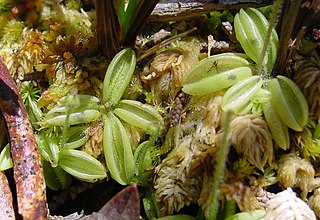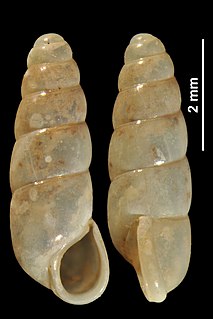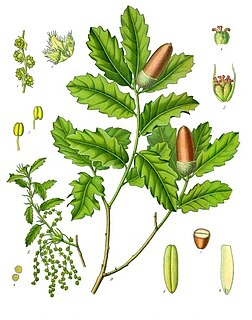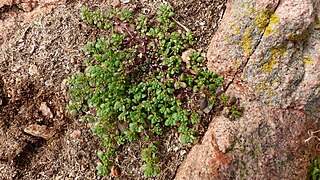
Cupressus lusitanica, ; cedro blanco means white cedar and is also known as Mexican white cedar or cedar-of-Goa, is a species of cypress native to Mexico and Central America. It has also been introduced to Belize, Costa Rica and Nicaragua, growing at 1,200–3,000 metres (3,900–9,800 ft) altitude.

Pinguicula lusitanica, commonly known as the pale butterwort, is a small butterwort that grows wild in acidic peat bog areas along coastal atlantic western Europe from western Scotland and Ireland south through western England and western France to the Iberian Peninsula and Morocco in north-western Africa.

The gold-striped salamander or golden-striped salamander is a species of salamander in the family Salamandridae. It is the only species of the genus Chioglossa. It is found in the north-west of Iberia at an altitude of up to 1,300 m. It is threatened by habitat loss.

Prunus lusitanica, the Portuguese laurel cherry or Portugal laurel, is a species of flowering plant in the rose family Rosaceae, native to southwestern France, Spain, Portugal, Morocco, and Macaronesia.
Acicula norrisi is a species of land snail in the family Aciculidae. It is native to Gibraltar. Some shells were recently found on the nearby Spanish mainland, indicating that there may be several populations there, as well.

Platyla foliniana is a species of very small land snail in the family Aciculidae. It is endemic to France, where it is known only from Alpes-Maritimes.

Platyla is a genus of very small land snails with an operculum, terrestrial gastropod mollusks or micromollusks in the family Aciculidae.
Platyla maasseni is a species of very small land snail with an operculum, a terrestrial gastropod mollusk or micromollusk in the family Aciculidae. This species is endemic to Serbia and Montenegro.
Platyla microspira is a species of very small land snail with an operculum, a terrestrial gastropod mollusk or micromollusk in the family Aciculidae. This species is found in Italy and Romania.
Platyla peloponnesica is a species of very small land snail with an operculum, a terrestrial gastropod mollusk or micromollusk in the family Aciculidae. This species is endemic to Greece.

Platyla polita is a species of very small land snail with an operculum, a terrestrial gastropod mollusk or micromollusk in the family Aciculidae.

Quercus lusitanica, commonly known as gall oak, Lusitanian oak, or dyer's oak, is a species of oak native to Portugal, Spain and Morocco. Quercus lusitanica is the source of commercial nutgalls. These galls are produced by the infection from the insect Cynips gallae tinctoriae. They are used for dyeing.

Erica lusitanica is a species of flowering plant in the family Ericaceae, known by the common names Portuguese heath and Spanish heath. It is native to Portugal, Spain and southwestern France. It is named for Lusitania, a historical region encompassing most of modern Portugal and parts of western Spain.
Selenemys is an extinct genus of pleurosternid turtle from the Late Jurassic of Central West of Portugal. It is known from several specimens recovered from the Lusitanian Basin, dating to the upper Kimmeridgian age. It was one of the earliest European pleurosternids, more closely related to the later Cretaceous pleurosternids of Europe than the contemporary pleurosternids of North America. This genus was named by Adán Pérez-García and Francisco Ortega in 2011, and the type species is Selenemys lusitanica.
Dagetichthys lakdoensis is a species of freshwater sole native to the Bénoué basin in Cameroon, with recent records from Nigeria in the Niger Delta. This species grows to a length of 40 centimetres (16 in) TL. This species is one of only two known members of its genus, the other being the marine Dagetichthys lusitanica.

Fritillaria lusitanica is a species of plant in the lily family Liliaceae, endemic to the Iberian Peninsula.

Herniaria lusitanica berlengiana is an endangered subspecies of flowering plant in the family Caryophyllaceae. It is endemic to the Berlengas Archipelago, Portugal.










